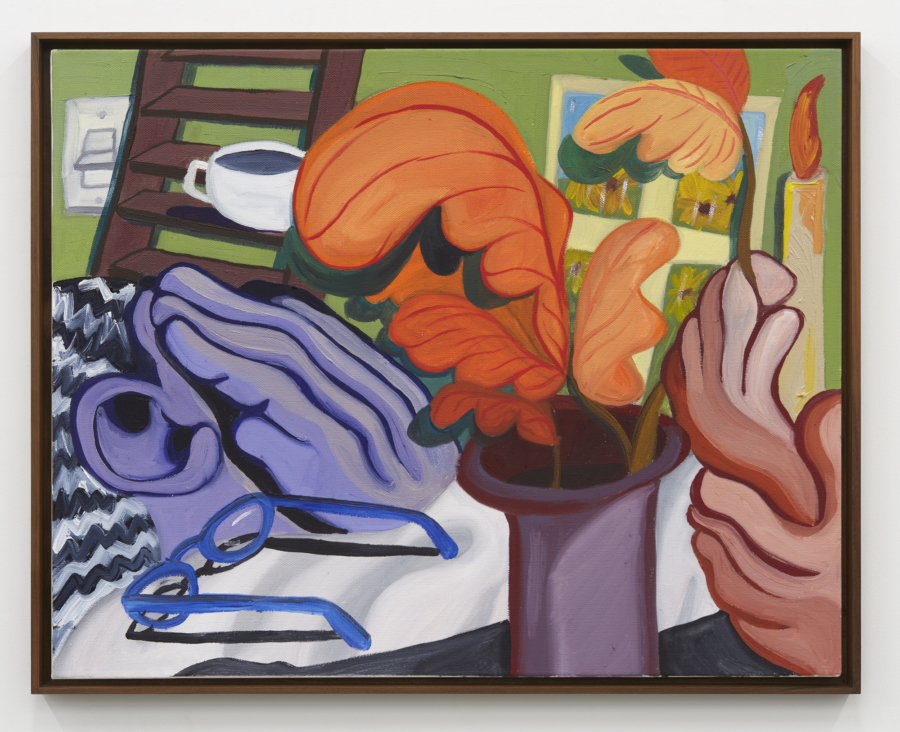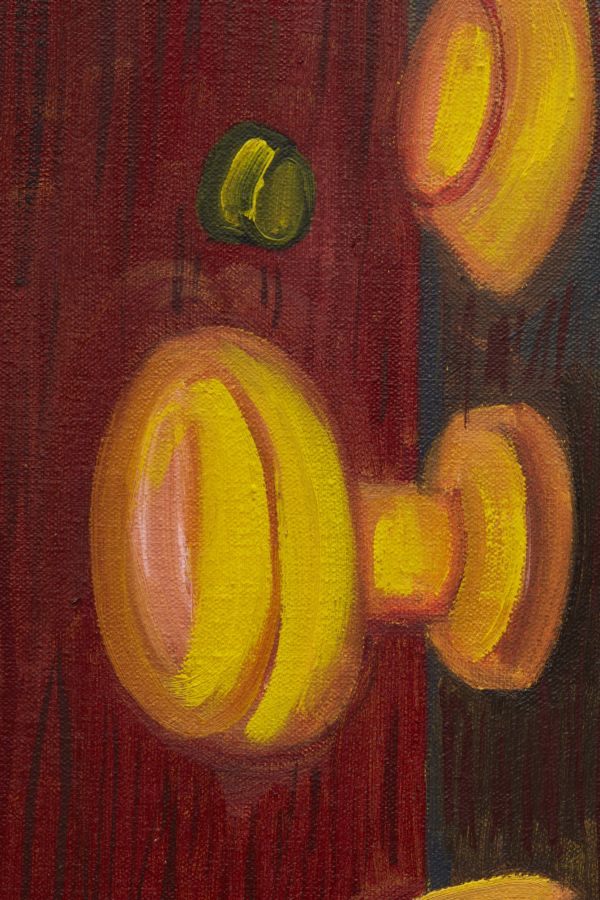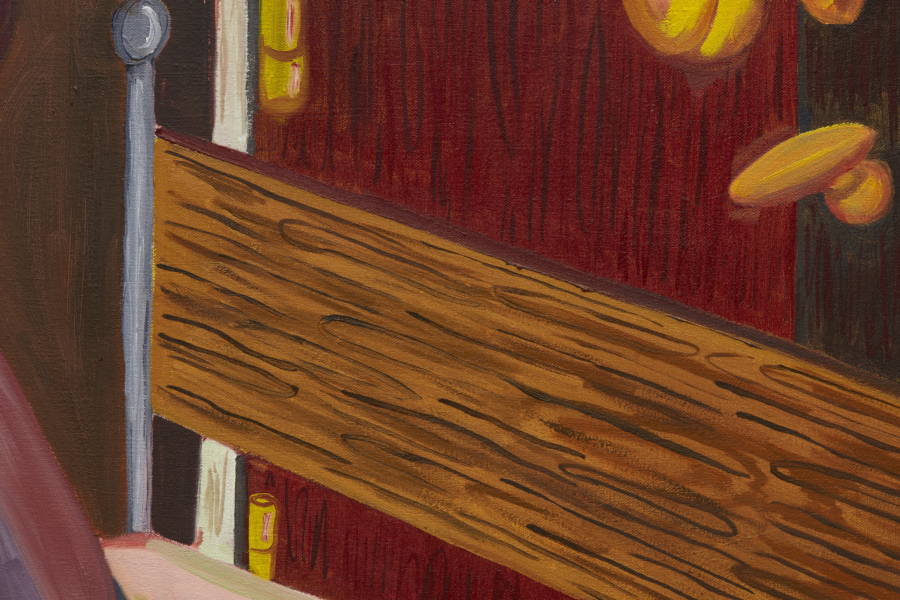Woody De Othello
About Face
Online Viewing Room
February 23-March 30, 2021
Woody De Othello
About Face
Online Viewing Room
February 23-March 30, 2021
by Aruna D’Souza The Things We’re Feeling
by Aruna D’Souza
Woody De Othello’s ceramics hover somewhere between animate and inanimate. An impossibly large, bright yellow box fan sags under its ridiculous weight—or perhaps it contracts itself so that it can blow more air into a room. An ultramarine telephone seems to morph and tremble, ready to speak its secrets into someone’s ear. A radiator appears ready to bolt away on clawed feet. The objects Othello chooses to represent in these and other works are analogous to, or extensions of, our bodies—they respirate, they communicate, they speak and listen, they exude warmth. Thanks to his play with scale, his use of pop-bright glazes, and his simplified forms, these sculptures are both eerie and delightful. They vibrate with life, but they also convey a kind of exhaustion, a heaviness, a deflation. It’s not easy being a thing.
Nor, in 2021, is it so easy being a human. It hasn’t been—let’s face it—for a while. But a year into the global pandemic, and centuries into the violent iteration and reiteration of white supremacy in this country, the relentless stress on our bodies and minds, the fraying of our relationships, the loneliness, the sheer weight of the burden of living on our shoulders—some shoulders more than others, to be sure, since pain and suffering are as unequally distributed, as segregated, as almost everything else in this world—is almost unbearable. And yet, life, if we’re lucky, limps on.
The works on view in About Face—six oil-on-canvas paintings, made between 2020 and 2021—offer endless ways of imagining the strange experience of now, but do so in the most paradoxical possible manner: thanks to a high-keyed palette, the pulsation of contrasting colors, and a cartoonish cast of characters, the pathos on display sneaks up on you. I Think That We Should Talk (2020), for example, distills in an almost uncanny way the heartbreak and strange silence of a difficult conversation. Two figures sit, side by side: one bows his head into his clasped, red, impossibly large hands with elongated, pinkish fingers; the other makes an unreadable gesture as he tries to explain the unexplainable. (We cannot see their faces; their hands, like those of most of the figures depicted in this suite of paintings, tell the story here.) Two glasses sit in front of them, one small, the other very large. It is as if these innocent objects hold the key to a larger narrative about power and powerlessness, dominance and submission—about how, that is to say, these two souls got to where they find themselves.
The person in Out of Body, Out of Mind (2020) sits on a bed in a room that seems too small to contain it: its headboard blocks the half-open doorway. (Is it half open? The handle and deadbolts hang in the open void, suggesting it’s also closed.) Behind him, what looks at first to be a draped window reads simultaneously as a picture of a closed stage curtain; a clock with no hands hangs on the wall (what does time mean during Covid-19?). The color combinations are jarring—reds and ochres and golds, but also pink and lime green and various shades of purples. This is not a place of repose. It is, rather, a claustrophobia-inducing space, one that traps the mind as much as it traps the body. The figure covers his face with his hands—again, the hands—in what can only be read as despair; his shadow, which seems to detach from his body and take on a material presence of its own, clasps him in an embrace that is at once tender and terrifying. The dissociation induced by isolation is complete.
The frustration of the insomniac is conveyed in Sleep Patterns (2020) not just through the strangely undulating fingers covering the face of the purple-skinned man, but also through his spectacles, which lie next to him—a naïve and hopeful preparation for slumber—and the coffee cup that rests on a ladder behind him. In this too-bright room whose palette careens between mauve, orange, and lime green, another large set of hands (this time with body unattached) holds a plume-like leaf plucked from a vase nearby. The fragmentation of the space and the illegibility of that second pair of hands suggests a kind of dreaming that our insomniac is desperately in want of.
Othello has long made paintings and drawings alongside his fantastical ceramic objects—he talks about the former as aids in envisioning the world in which the latter live. And so what can we make of this world? It is one in which there exists a kind of feedback between the objects and architecture and their human counterparts, a form of empathy between the so-called inanimate elements of the images and the people who live alongside them. The walls, the windows, the doors, the vases, the chairs, the cups, the stools, the telephones—they are not just props or symbols. Indeed, they seem to absorb or channel or even induce the emotional states of their human counterparts, becoming actors in their own right. It seems no coincidence that Night Stand (2021) is titled after the red table whose drawer juts out and whose lamp seems ready to tip over—the wild shifts in perspective and instability of form tell us all we need to know about the figure gripped with anxiety who sits beside it. He is all of us, as we try to survive alone—literally or emotionally—in our rooms, confronting our loneliness, our fear, our sleeplessness, our isolation, reaching for the things around us that might help us make the irrationality of existence make sense. The wondrous thing, in Othello’s world, is that those things, in a sense, reach back—not precisely easing our loneliness, but perhaps showing that we are not, in fact, entirely alone.

Woody De Othello
I Think That We Should Talk, 2020
Oil on canvas
24 × 44 inches; 61 × 111.8 cm
WDO-20-020
Woody De Othello
I Think That We Should Talk, 2020
Oil on canvas
24 × 44 inches; 61 × 111.8 cm
WDO-20-020

Woody De Othello
Sleep Patterns, 2020
Oil on canvas
16 × 20 inches; 41 × 51 cm
WDO-20-023
Woody De Othello
Sleep Patterns, 2020
Oil on canvas
16 × 20 inches; 41 × 51 cm
WDO-20-023

Woody De Othello
Out of Body, Out of Mind, 2020
Oil on canvas
50 × 40 inches; 127 × 101.6 cm
WDO-20-022
Woody De Othello
Out of Body, Out of Mind, 2020
Oil on canvas
50 × 40 inches; 127 × 101.6 cm
WDO-20-022

Woody De Othello
Reaching Out, But Not Connecting, 2021
Oil on canvas
30 × 24 inches; 76 × 61 cm
WDO-21-005
Woody De Othello
Reaching Out, But Not Connecting, 2021
Oil on canvas
30 × 24 inches; 76 × 61 cm
WDO-21-005

Woody De Othello
Holding Back, 2020
Oil on canvas
24 × 18 inches; 61 × 46 cm
WDO-20-021
Woody De Othello
Holding Back, 2020
Oil on canvas
24 × 18 inches; 61 × 46 cm
WDO-20-021

Woody De Othello
Night Stand, 2021
Oil on canvas
16 × 20 inches; 41 × 51 cm
WDO-21-003
Woody De Othello
Night Stand, 2021
Oil on canvas
16 × 20 inches; 41 × 51 cm
WDO-21-003



































